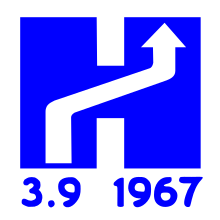Dagen H
Dagen H ('day H', 'H' for Swedish Högertrafikomläggningen = 'right-hand traffic changeover ') is the name for the changeover to right-hand traffic , which took place on Sunday, September 3, 1967 at 5 o'clock in Sweden . From that point on you had to drive on the right lane instead of the left.
history
The first legal traffic regulation was issued in Sweden in 1718. However, this regulation was not long-lived. In 1734 it was replaced by a new one that stipulated left-hand traffic . Left-hand traffic was not a problem in the country before the automobile began to spread in earnest and traffic became international .
Now the demand arose to adapt to the transport system that dominates the Western European continent. The road safety was to move a reason to legal relations. The cars in Sweden had the steering wheel on the left-hand side like today, which made it difficult to overtake safely .
As early as 1927, a committee proposed investigating the cost of moving to the right hand traffic. New proposals for the introduction of right-hand traffic came up in the Reichstag in 1934, 1939, 1941, 1943, 1945 and 1953.
The inner-city traffic junction Slussen , planned in the 1930s , between Stockholm's old town and Södermalm , was already designed for right-hand traffic. The roundabout was operated from 1935 to "Dagen H", however, with left-hand traffic.
In 1954, a committee clearly and unequivocally suggested that right-hand traffic should be introduced. In October 1961 there was an investigation into the costs of a transition to right-hand traffic from Gösta Hall . According to his calculations, the cost was 2.7 million Swedish kronor based on the monetary value in 1961, including 500,000 kroner for information material alone.
The Swedish plans for the transition to right-hand traffic were also observed abroad. The Nordic Council recommended that Sweden introduce legal traffic and the Advisory Assembly of the Council of Europe adopted a resolution calling for a unified transport system.
Referendum
In 1955, an advisory referendum was held. It showed that, at 82.9%, an overwhelming majority of those who voted wanted to keep left-hand traffic, while only 15.5% wanted to switch to right-hand traffic. The participation was 53.2% of the voters.
Contrary to the result of the referendum, eight years later, on May 10, 1963, the Reichstag decided by 119 votes to 16, with 4 abstentions (and 12 absent MPs) that Sweden would move to the legal market for 1967.
Vehicles of that time
Most Swedish cars traditionally had the steering wheel installed on the left. Even the imported British cars were built that way. In left-hand traffic, this led to a considerably higher risk when overtaking due to the comparatively poor visibility. On the other hand, the cars with the steering wheel arranged on the edge of the road were able to drive closer to the edge of the road, and their drivers were exposed to less glare at night than their counterparts.
In left-hand traffic, buses and one-way trams had the driver's seat on the right and the entrances on the left.
The old trams in Sweden had to make the greatest sacrifice : apart from Gothenburg , Malmö , Norrköping and two lines in the greater Stockholm area , all trams across the country were shut down. However, the "Dagen H" was only the occasion, the affected municipalities wanted to discontinue the tram operations in accordance with the zeitgeist anyway. In Malmö it didn't happen until 1973, a few years later. In Gothenburg and Norrköping, the changeover had been prepared in advance by purchasing trams designed for right-hand traffic.
The Stockholm subway, as well as the Swedish railways, still operate on the left as a rule. However, double-track lines are mostly equipped for track changing operations. Some systems built later are operated with right-hand drive, such as the Stockholm Tvärbanan , where there are road-flush sections in Gröndal and Solna . At the Nockebybanan there has been a change of side at the Alléparken stop at the transition to the public street due to the connection in Alvik since the "Dagen H".
execution
In preparation, a 30-page brochure was distributed to all households, and information programs were broadcast on television and radio. The “State Legal Traffic Commission ” (Statens Högertrafikkommission, HTK) was responsible for the conversion .
Four hours before the changeover and one hour afterwards, all private car traffic was prohibited - in some cities even for 24 hours. During this time, all traffic signs for right-hand traffic were implemented. Many voluntary helpers, but also members of emergency organizations and those doing military service, were deployed. The maximum speed in built-up areas was reduced by 10 to 40 km / h , but gradually increased to the previous level over the course of a month.
At the roadside, hexagonal signs with a yellow border and a yellow “H” on a blue background (see photo) were set up to remind road users to keep to the right.
At 4:50 a.m. on Sunday morning on September 3, 1967, all vehicles had to stop on the left side of the road. After a short stop, they carefully changed the side of the street and waited there until 5 a.m. The exact time was announced nationwide via radio. Then they continued on the right-hand side. The switch was reported live on Swedish radio.
After the conversion, traffic monitoring was intensified, around 10,300 police officers and soldiers were deployed. In addition, over 100,000 people - high school students, army recruits and members of associations - were used to regulate traffic at pedestrian crossings.
Anecdotal
On September 2, 2017, the city of Malmköping celebrated the 50th anniversary of the introduction of right -hand traffic in 1967. The changeover (Högertrafikomläggning) was celebrated by driving selected streets in left-hand traffic from 11 a.m. to 3 p.m. Old-timer vehicles and old buses from the Malmköping Tram Museum , which were designed for left-hand traffic, drove “properly” again.
Web links
- with reports from the H-Högkvarter ("H-Headquarters" ) set up in the Stockholm ( Memento from July 6, 2013 in the web archive archive.today ) Reichstag building ; with (from left to right) Carl-Gunnar Hammarlund from Traffic Broadcasting , Transport Minister Olof Palme and Lars Skiöld from der State Legal Traffic Commission ), Malmö (Kungsgatan), Luleå , Göteborg (Korsvägen), Örebro and Stockholm .
- Changing lanes: The world should learn from a Swedish switch . In: The World In 2017





